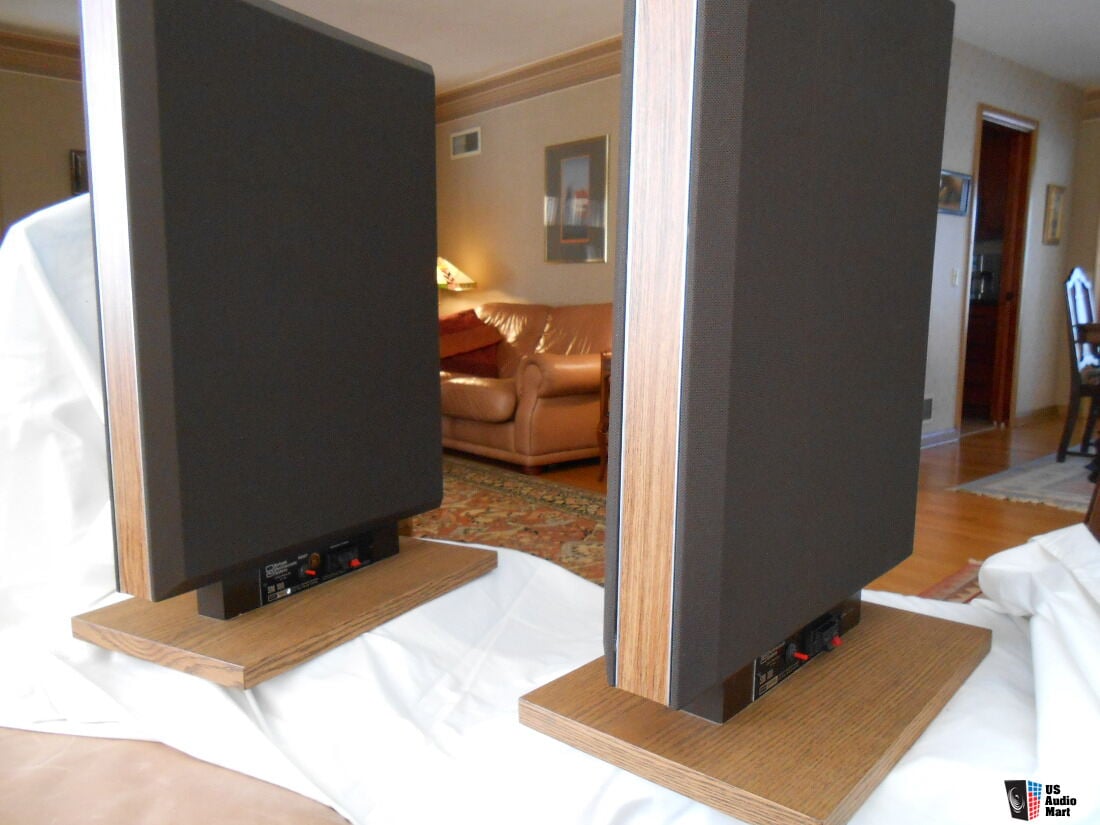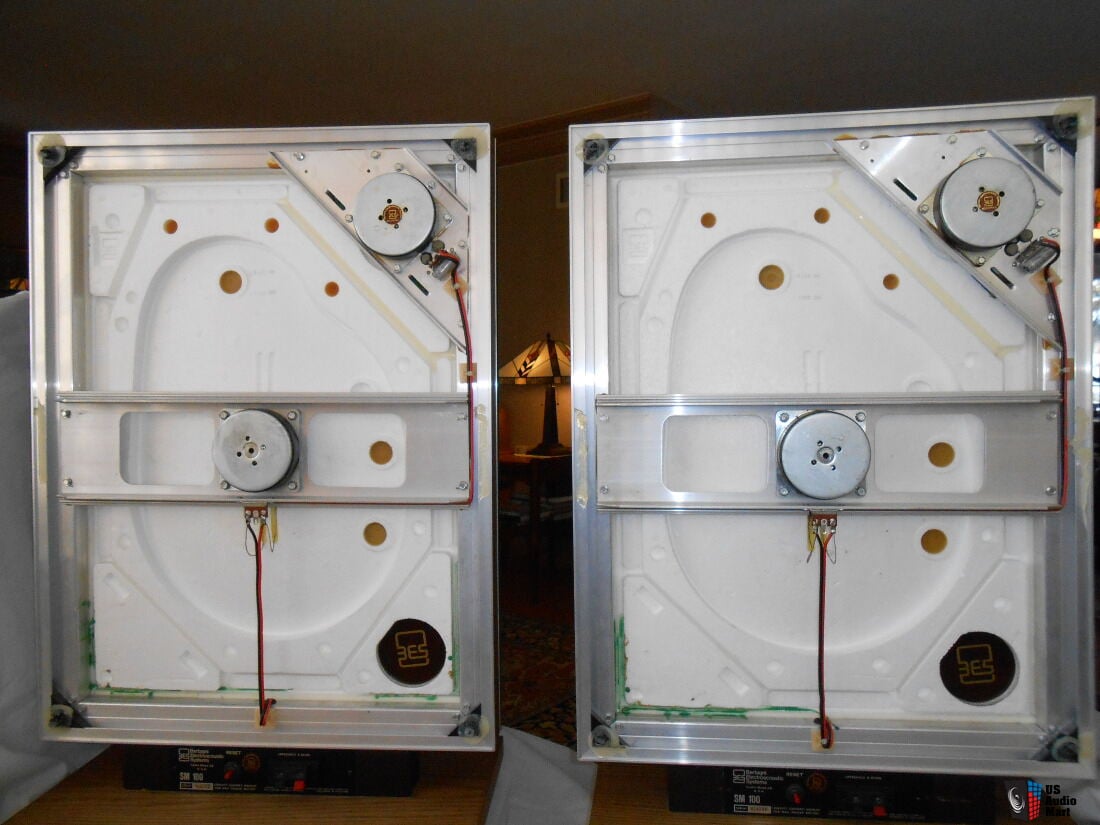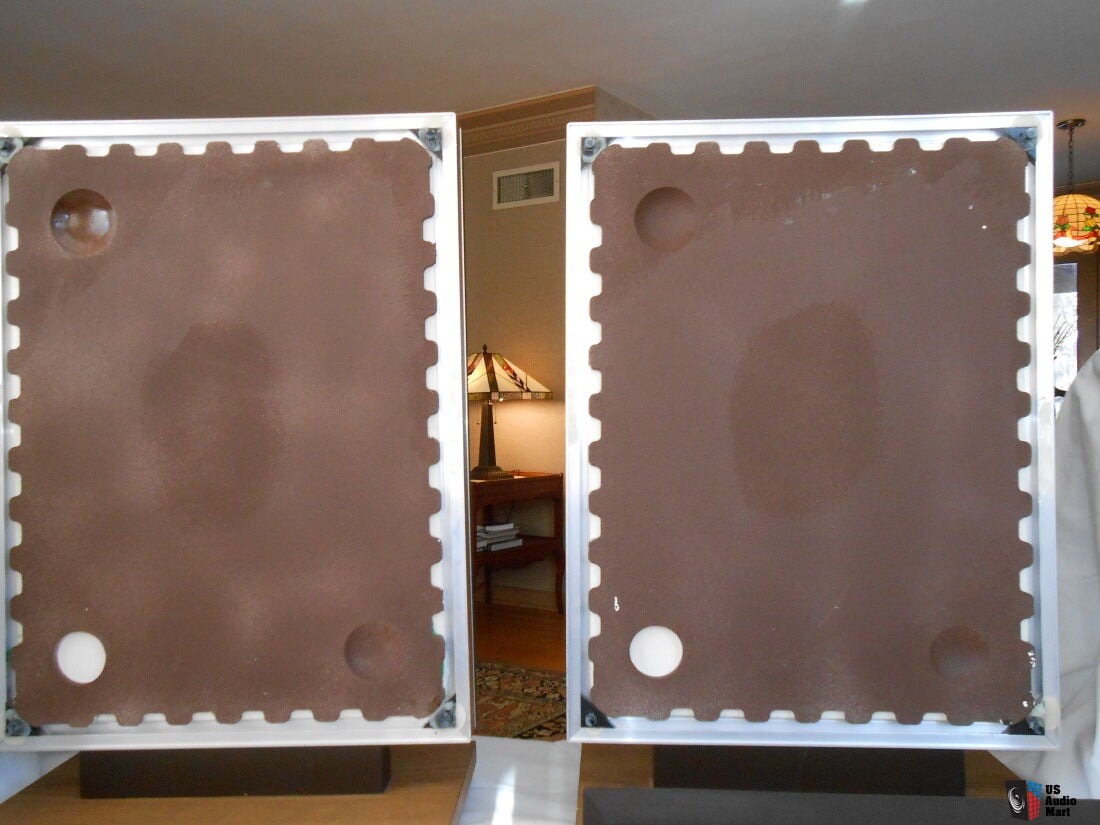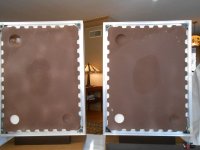I for one cannot see how hanging panels with strings is going to work as well as some kind of clamping or securing with foam tape. Surely one needs to allow the panel to do its thing without being free to waft around.
Anyway, it's time to cut the poplar plywood. It's half the density or thereabouts of birch ply, but with a similar modulus of elasticity (which I take to be bendability).
The clamps are only used to hold the corner molding to the frame until the glue dries. lol
I would love to hear of your design and how you would mount the panel? Maybe you have a technique that I don't know about that works great?
Last edited:
Thank you, great info. I think I understand now how you mount the panels. I am a bit surprised that the panels are held firmly, as this is (as lordtarquin says) very different to dangling freely from strings.to SANDWICH the panel together to firmly hold it in place. This technique will reduce unwanted resonance.
The clamps are only used to hold the corner molding to the frame until the glue dries. lol
I would love to hear of your design and how you would mount the panel? Maybe you have a technique that I don't know about that works great?
I'm still playing! There's a picture somewhere of where the main mode activities are, and where nothing much seems to happen. My thinking is that in the first instance, if one secures the panel to the frame with foam tape at the parts of the edge where little bending is happening, then the panel has the maximum opportunity to do its bending thing in an unconstrained way. There were two zones on the short edge, each about a quarter way across from the corners, and three zones on the long edge, distributed pretty evenly across the length.
My panels are running from 300hz or so upwards, so there's not going to be a huge voltage going through the exciters, or large amounts of bass excitement.
The poplar ply panels are now nearly prepared with the usual corner rounding. They have been sanded and a thin coat of 1:2 PVA/water applied per side. The idea here is to seal the panel and fill any microscopic gaps in the surface. When the PVA is dry, I'll sand them again and possibly wire-wool them. But that's tomorrow's job. I will weigh them too- they seem very light.
The poplar ply panels are now nearly prepared with the usual corner rounding. They have been sanded and a thin coat of 1:2 PVA/water applied per side. The idea here is to seal the panel and fill any microscopic gaps in the surface. When the PVA is dry, I'll sand them again and possibly wire-wool them. But that's tomorrow's job. I will weigh them too- they seem very light.
Did you try listening to them before applying the PVA? I'd be curious to know if it makes a difference.
In my "DML lab" (i.e. basement), I have developed a few simple ways of listening to panels without actually doing any construction. The simplest is the following: on the top of a small bench (about 2 ft tall) I place a plastic laundry basket (open end up). On the top rim of the laundry basket I place a few pieces (usually three) of adhesive backed foam. I can then place any panel I want to test (no matter what size or shape) on top of the foam pieces. I then place my exciter (or exciters) on top of the panel, and wire up using alligator clips. Then I play music, or test signals, on this simple makeshift laundry basket DML. Usually, a little pressure is required on top of each exciter to keep them from bouncing around. I just apply gentle pressure with my hands, or, simply place a bit of foam and a light weight on top of each exciter. With this setup, I can get a pretty good idea of the efficiency and overall sound character of the panel, regardless of the size and shape of the panel, without actually building a frame and attaching the panel, and without actually taping the exciter in place. Plus, using the weights to hold the exciters in place frees my hands to allow me to change songs, or test signals and hold and operate any measuring devices.
My second, slightly more complicated test setup is this: I built a pair of frames similar to what DMLBES described, with foam on the face of each. I can then sandwich a panel between the two frames and clamp the two frames together. I can arrange the foam however I want (i.e. full surround, leave corners free, etc) to create a wide variety of edge constraint conditions. Typically I lay this frame/foam/panel/foam/frame sandwich flat on top of my trusty laundry basket, place exciters on the panel and listen and test exactly as I described above. This version helps to understand the effects of the frame, but limits to panel size and shape that can be tested.
Anyone else have their own "lab" methods for DML development?
Eric
Did you try listening to them before applying the PVA? I'd be curious to know if it makes a difference.
Eric
No, but I have a second pair of poplar ply sheets I can try if needed. The sanding will remove some of the PVA, but leave any gaps filled (hopefully).
The test rig sounds very useful!
I'm pondering the securing of the panel to the frame now. I've read various papers about where to secure it and how rigidly, including this one: WO1999052324A1 - Acoustic device relying on bending wave action
- Google Patents
I've read various papers about where to secure it and how rigidly, including this one: WO1999052324A1 - Acoustic device relying on bending wave action
- Google Patents
That's one I have not come across before. I skimmed it it looks interesting. Will have to give it a more serious read through.
Thanks,
Eric
Thank you, great info. I think I understand now how you mount the panels. I am a bit surprised that the panels are held firmly, as this is (as lordtarquin says) very different to dangling freely from strings.
I forgot to mention that when using the Frost King foam you can control the amount of damping. Instead of using one continuous strip of FK foam you can cut them into 1-2 inch pieces and space them 1-2 inches apart for LESS damping.
No, but I have a second pair of poplar ply sheets I can try if needed. The sanding will remove some of the PVA, but leave any gaps filled (hopefully).
The test rig sounds very useful!
I'm pondering the securing of the panel to the frame now. I've read various papers about where to secure it and how rigidly, including this one: WO1999052324A1 - Acoustic device relying on bending wave action
- Google Patents
Although I just skimmed through that article it basically is saying what I've been saying about the use of frame/spline and damping/restraining/clamping of edges. My "SANDWICH" technique is basically clamping of the edges of the panel to hold it firmly and securely in (with frost king foam) place to prevent unwanted resonance.
For those that don't know my designs are inspired from Dr. Jose Bertagni from BES, Bertagni electroacoustic systems. In that article at the very beginning he mentions BERTAGNI as his background. Dr. Jose Bertagni has many patents on his DML loudspeakers.
Last edited:
Here's another paper, this time a PhD thesis from 2008: https://riunet.upv.es/bitstream/handle/10251/3347/tesisUPV2873.pdf
Again, it reinforces the benefits of an 'elastic boundary' over and above a freely supported (e.g. suspended on strings) one, in particular a smoother frequency response presumably due to better damping of panel resonances.
Again, it reinforces the benefits of an 'elastic boundary' over and above a freely supported (e.g. suspended on strings) one, in particular a smoother frequency response presumably due to better damping of panel resonances.
Great info here that you all are collecting for this thread. My drivers (exciters) arrived days ago but I have not had a chance to go buy the XPS panels yet. Now I wonder if I should get something else. Maybe order those carbon fiber honeycomb panels from AliExpress.
Great info here that you all are collecting for this thread. My drivers (exciters) arrived days ago but I have not had a chance to go buy the XPS panels yet. Now I wonder if I should get something else. Maybe order those carbon fiber honeycomb panels from AliExpress.
I've just weighed my identically sized panels (564 x 400mm). Ultra high density 25mm EPS with PVA treatment = 180g. 3mm poplar plywood with one coat of 1:2 PVA/water per side and sanded = 260g. Baltic ply is denser still, so would expect it to tip the scales at around 400g. Spruce would be similar to poplar in density. Bendability for each seems similar as far as I can tell.
With luck, they will be up and running today, but a bad back means slow work in short sessions.
For those that don't know my designs are inspired from Dr. Jose Bertagni from BES, Bertagni electroacoustic systems. In that article at the very beginning he mentions BERTAGNI as his background. Dr. Jose Bertagni has many patents on his DML loudspeakers.
I didn't know. But a quick search reveals some cools stuff indeed:
Bertagni Electroacoustic Systems (BES) SM-100 Speakers Photo #1096125 - US Audio Mart
So the panel is "contoured" expanded bead PS right? What in the upper right? Is that a "tweeter"?
Eric
I didn't know. But a quick search reveals some cools stuff indeed:
Bertagni Electroacoustic Systems (BES) SM-100 Speakers Photo #1096125 - US Audio Mart
So the panel is "contoured" expanded bead PS right? What in the upper right? Is that a "tweeter"?
Eric
Yes it is Expanded Polystyrene (EPS). The upper right is a exciter that is used as a high frequency transducer, while the other exciter in the middle is used for the low frequencies. The exciter used for the high frequencies uses a single non polarized electrolytic (16uf) capacitor, which is around 1200khz.
Bertagni speakers are a advanced design as you will either have to have a CNC machine and or be a experienced sculptor. I have 4 years of sculpting experience LOL.
I didn't know. But a quick search reveals some cools stuff indeed:
Bertagni Electroacoustic Systems (BES) SM-100 Speakers Photo #1096125 - US Audio Mart
So the panel is "contoured" expanded bead PS right? What in the upper right? Is that a "tweeter"?
Eric
The first time I saw and heard Bertagni's was back in the early 70's. I thought they looked cool being so thin and they didn't sound half bad either...no fake booming 100 Hz bass hump and no burning sizzle on the high end. But what I really thought was cool was when the sales guy took the back off and all you could see were the driver magnets and styrofoam...I thought, now why in the world would they stuff a speaker cabinet with styrofoam instead of wool? lol, I'm not sure the salesman even knew what he had there...
Bertagni SM-100's not mirrored? Maybe it doesn't matter too much with DMLs being almost omni-directional?
I didn't know. But a quick search reveals some cools stuff indeed:
Bertagni Electroacoustic Systems (BES) SM-100 Speakers Photo #1096125 - US Audio Mart
So the panel is "contoured" expanded bead PS right? What in the upper right? Is that a "tweeter"?
Eric
This is really useful and gives some insights into DML design. One thing that stands out is the very substantial support both for the main exciter and the tweeter.
Bertagni SM-100's not mirrored? Maybe it doesn't matter too much with DMLs being almost omni-directional?
No, its not mirrored. It does matter as its all design dependent. All DML's use the back side of the panel for rear wall reflections which is what creates that Live type of omini directional sound. This is the reason why DML's need at least 2ft. away from the back wall as they use the back walls for reflection. DML's are NOT ideal when the back side of the panel is enclosed which is why they shouldn't be used as picture frames and or placed to close to the back walls. Covering/enclosing the back side of the DML panel will make them lose most of there omini directional sound.
When the front and back of panels are mirrored then they are true Bipolar as they will radiate the same sound equally from both sides. When you carve indentions, grooves, channels ect on one side and not the other then I believe they become out of phase to a degree and are no longer Bipoles but Dipoles due to one side being slightly out of phase then the other hence why I say its all design dependent.
I agree DMLBES, but in this instance I was commenting on the fact that both units have the tweeter on the left side, and are not mirrored on the front. Unless, this pair is made up of two left or right units? Looking closer I now see that they are consecutive serial numbers, so it appears all units were made the same with no designated left and right speaker.
Not quite sure what this 'brown stuff' on the front(?) of the diaphram is? Some form of damping?
Not quite sure what this 'brown stuff' on the front(?) of the diaphram is? Some form of damping?
Attachments
Last edited:
I didn't know. But a quick search reveals some cools stuff indeed:
Bertagni Electroacoustic Systems (BES) SM-100 Speakers Photo #1096125 - US Audio Mart
So the panel is "contoured" expanded bead PS right? What in the upper right? Is that a "tweeter"?
Eric
I like how this looks covered with a grille - although it looks more like a conventional speaker now.

Looks like a custom molded ribbed EPS foam is the main resonator panel. is the corner tweeter an isolated small panel of just another driver attached to corner?

Looks like the front radiator is covered with open cell foam?

I think the brown foam may actually be the both the suspension and damping material for the EPS panel, given the corrugated dovetail edges.
So open cell foam bonded to the EPS radiator panel on the face, but attached to the frame at the edges to "float" the EPS panel in 3d space.
Last edited:
- Home
- Loudspeakers
- Full Range
- A Study of DMLs as a Full Range Speaker
